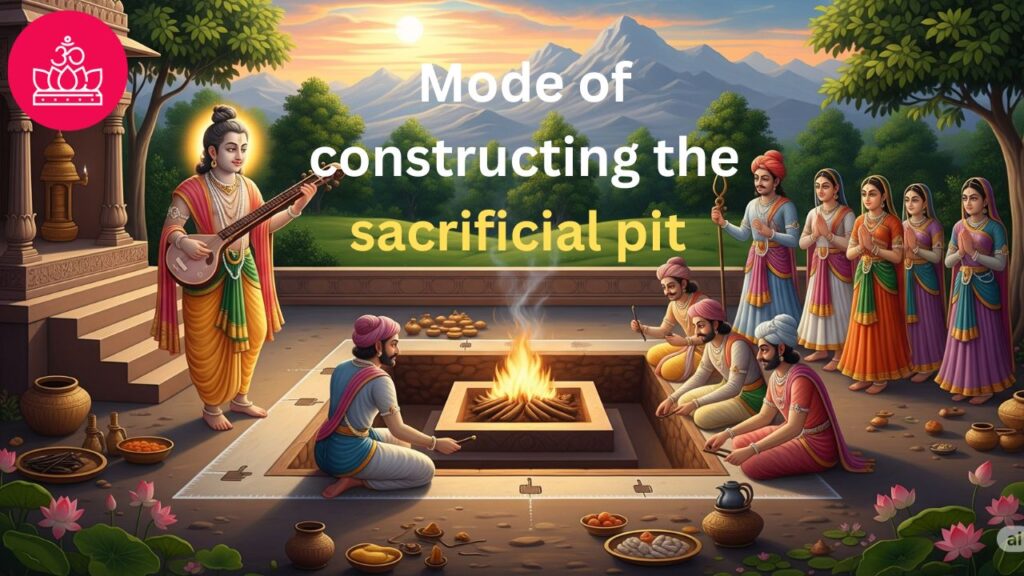The Sacred Fire: Constructing the Sacrificial Pit and Offering Oblation
As told in: Agni Purana – Chapter 24: Mode of constructing the sacrificial pit and the oblations unto fire
This chapter of the Agni Purana meticulously details the construction of a sacrificial pit and the precise rituals involved in offering oblations to the sacred fire. It’s a guide not just to a physical process, but to a spiritual journey, emphasizing the importance of precision, devotion, and the interconnectedness of the ritual with the cosmos. The instructions are remarkably detailed, reflecting the high value placed on the correct performance of these ancient rites. The narrative unfolds not as a mere set of instructions, but as a path towards spiritual fulfillment, offering both material and spiritual rewards.
# Designing the Square Pit: A Foundation of Precision
The chapter commences with Narada, the revered sage, explaining the method of fire oblation, promising the fulfillment of all desires to those who perform it correctly. The instructions begin with the construction of a square pit. The dimensions are specified with astonishing accuracy: “One has to dig a square pit after having measured out with a thread, four times, twenty-four thumbs in length.” This meticulous measurement is not arbitrary; it underscores the importance of precision in sacred rituals. Every detail, from the width of the surrounding girdle (two thumbs) to the dimensions of the internal seats (12, 8, and 4 thumbs in the east; 10, 6, and 4 thumbs in the west), is crucial. The western seat, shaped like a fig leaf, slightly embedded in the pit, adds a symbolic element, connecting the ritual with the natural world and its sacred imagery. A drain, precisely quarter of a thumb in breadth and fifteen thumbs in length, is also described, adding to the intricate design. The dimensions are further scaled for larger pits, demonstrating a flexibility within the framework of precise measurement. This meticulous description highlights the importance of adhering to established norms and procedures in religious practices. The precision demanded emphasizes the seriousness and sacred nature of the act.
# The Circular Pit: A Symbol of Cosmic Harmony
The instructions then shift to the construction of a circular pit, a different geometric representation of the cosmos. The method is equally precise, utilizing a rope to mark the circle, ensuring the perfect roundness symbolic of wholeness and cosmic harmony. The placement of the pit, “a crescent-shaped pit east-west, and away from the northern direction, half (the size) of the pit and half the angular portion,” is not random but carefully chosen to align with auspicious directions. The girdles around this pit are described as resembling lotus petals, further emphasizing the connection between the ritual and the natural world. The ladle’s size (“the size of an arm”) is also specified, again highlighting the importance of standardized tools in the ritual. This section emphasizes the versatility of the ritual, adaptable to different spatial arrangements while maintaining the core principles of precision and cosmic alignment.
# Preparing the Sacred Space: Purification and Consecration
The next section details the preparation of the area surrounding the pit, emphasizing purification. The ground is meticulously leveled and purified, “evenly, horizontally and upwards (to the extent of) half a thumb (and) one-fourth of a thumb.” A boundary line is carefully drawn, with precise specifications for its width and shape. The meticulous cleaning and precise outlining of the space are not merely aesthetic concerns but essential steps in creating a sacred and pure environment for the ritual. The description of the pit’s mouth and central portion again stresses the importance of exact measurements and the careful shaping of the sacred space. Even the size of a hole at the neck of the pit (“that the little finger would enter”) is specified, showing the level of detail involved in the construction.
A unique marking, “vajranāsikā,” is described, involving the drawing of lines with a fine tip, symbolizing the precise and methodical approach required for this sacred act. The consecration of the space with the syllable Om further highlights the sacred dimension of the ritual. The creation of a seat where the energy of Vishnu rests emphasizes the divine presence that permeates the entire process. This section clearly shows that the preparation is not just about the physical creation of the pit, but a ritualistic purification and consecration of the space, making it a suitable vessel for the sacred act.
# The Ritual of Oblation: A Symphony of Actions and Mantras
The detailed instructions for the ritual itself follow. The placement of the fire, the fuel, the ladles (sruk and sruva), and the vessels for clarified butter and caru (oblation of rice, barley, and pulse boiled together) are all meticulously described. The use of kusha grass, water, and the careful handling of the ladles emphasize the purity and reverence required. The process of purifying the clarified butter through straining and sprinkling is also described, demonstrating the importance of purity in the offerings.
The precise method of holding the kusha grass, the number of times the clarified butter is taken and cast, and the sprinkling of water on the ladles show the level of detail and the importance of following the prescribed procedure. The initiation of the fire oblation with the syllable Om and the concluding salutation emphasize the importance of mantras and proper invocation. This section emphasizes the precise sequence of actions and mantras, not just as arbitrary steps but as integral parts of a larger cosmic dance.
# Vedic Observances and the Significance of Repetition
The text then expands on the ritual’s context within a broader framework of Vedic observances, mentioning various rites such as Garbhādhāna (conception ceremony), Pumsavana (a ceremony to ensure a male child), Sīmantonnayana (parting of the hair), Jātakarma (birth ceremony), Nāmakaraṇa (naming ceremony), Annaprāśana (first feeding of the child), Cūḍākṛti (tonsure ceremony), and Vratabandha (observance marking the conclusion of study of the student). The text prescribes 64 oblations for each of these rites, highlighting the importance of repetition and the meticulous nature of the ritual practice. This section shows that the fire oblation is not an isolated event but part of a larger cycle of life-cycle ceremonies, each with its own significance and ritualistic requirements. The ritual is not just a physical act but a deeply symbolic representation of life’s journey.
# The Final Oblation and the Invocation of Vishnu
The chapter culminates in the description of the final oblation, emphasizing the importance of proper intonation and the use of the mystic formula ending with “vauṣaṭ.” The purification of the fire of Vishnu, the boiling of food intended for Vishnu, and the worship of Vishnu on the altar are described, emphasizing the divine presence in the ritual. The offering of clarified butter to the deity and its limbs, repeated hundreds or thousands of times, highlights the devotion and the dedication required in this sacred act. The subsequent sacrifice of animals, feeding the disciples, and the union of disciples with the preceptor further emphasize the communal and spiritual aspects of the ritual. This section highlights the culmination of the ritual, the offering of the final oblation, and the seeking of divine protection and grace.
# The Cosmic Creation and the Transfer of Power
The final part of the chapter delves into a profound cosmological meditation, visualizing the creation of the universe from a cosmic egg, symbolizing the cyclical nature of creation and destruction. The visualization of the Purusha (Supreme Being) at the center of the egg, the transfer of the linga (a symbolic representation of divine energy), and the assignment of limbs to different deities are all part of a deep meditative practice that brings the ritual to a higher spiritual level. The detailed description of this meditative process underscores the profound spiritual significance of the ritual, extending beyond the physical act to encompass a cosmic worldview.
# Conclusion: A Path to Fulfillment
The chapter concludes by describing the disciples’ worship of Hari (Vishnu) and Viṣvaksena, and the dismissal of Viṣvaksena after the offering of the remnants of the oblations. The final lines emphasize the duality of the ritual’s outcome: “One who is desirous of enjoyment gets all things. One who is desirous of release from mundane existence gets merged in Hari.” This emphasizes the multifaceted nature of the ritual, offering both material prosperity and spiritual liberation depending on the aspirant’s intention. The chapter, therefore, is not merely a manual of instructions but a spiritual guide, emphasizing the importance of precision, devotion, and the interconnectedness of the ritual with the cosmos, offering a path to both material and spiritual fulfillment.



